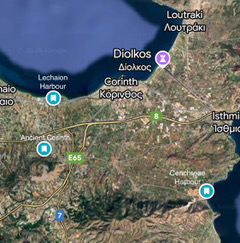Corinth

Casamara
John & Susan Simpson
Thu 24 Jul 2025 12:16
After a brief diversion out of St Paul territory, when we called at Meteora and Delphi, we turned our attention back to him in Corinth. The present city of Corinth (Korinthos) was built a couple of miles NE of Ancient Corinth after an earthquake devastated the old city in 1858. Another major earthquake ruined the new city in 1928, and in 1933 it was destroyed by fire. After such a series of disasters it’s perhaps not surprising that Corinth isn’t a beautiful city today, but the ruins of Ancient Corinth were well worth seeing. Ancient Corinth was strategically placed between the port of Lechaion on the Adriatic Sea and the port of Cenchrae on the Aegean Sea. A paved roadway called the Diolkos connected the two seas and this had been used for centuries to haul shipping and goods across the Isthmus at its narrowest point.  Positions of Ancient Corinth, Lechaion, Cenchrae and the Diolkos on the Corinthian Isthmus Corinth was a Roman colony when Paul arrived in 50 AD, the city having been rebuilt by Julius Caesar in 44 BC, and Paul stayed here 18 months. Initially he preached to Jews in the synagogue but, having encountered strong opposition from the Jewish community, he widened his teaching to include Gentiles. During his stay Paul was brought before the proconsul Gallio, having been accused of illegal teaching. According to tradition, the large elevated area in Ancient Corinth called the Bema was where Gallio would have heard the case against Paul. The Bema in the centre of Ancient Corinth Paul worked in Corinth for a while, alongside Aquila and his wife Priscilla, both Roman Jews who shared Paul’s profession as a tentmaker (leatherworker). It was interesting to see the Roman Agora (marketplace) and shop buildings. It was from Corinth that Paul wrote his first and second letters to the Thessalonians, encouraging the new believers he had left behind in Thessalonica to stand firm under persecution. In his later letters to the Corinthians Paul shows a deep affection for the Christian believers in Corinth, as well as concern for them maintaining their beliefs in a city where many pagan cultures came together. The Temple of Apollo was one of the few structures left standing when the city was rebuilt by the Romans in 44 BC so Paul would have seen this reminder of worshipping Greek gods. Corinthian Temple of Apollo Little remains of the two ancient harbours serving Corinth. We walked to Lechaion from our apartment in Korinthos and found the stone dock walls that would have lined the entrance to the man-made harbour. The harbour itself has long since silted up but we could see some archaeologists at work excavating the early Christian basilica that was constructed alongside the harbour. Believed to have been built around 450 AD, the basilica was the largest in mainland Greece and dedicated to Leonides, Bishop of Athens who was martyred in the mid-3rd century AD. Lechaion Harbour entrance There was a little more to see at Cenchrae, which was partly natural harbour and partly man-made. Two breakwaters were built at the end of two headlands, enclosing the bay in between to create the harbour. Earthquakes and subsidence have meant that the breakwaters are now two meters below the sea, but excavations have uncovered Roman buildings and an early Christian basilica. We read that stone signs have been placed by the ruins in the water so that snorkelers can identify what they are looking at. Unfortunately we didn’t have snorkel equipment to test that out! When Paul left Corinth in 52 AD he sailed from Cenchrae towards Syria. He is noted as having his hair cut here before he left, in order to fulfil a vow. In Paul’s letter to the Romans (written around 57 AD) he refers to Phoebe, a deaconess in the church at Cenchrae. He seems to suggest that she was travelling to Rome carrying Paul’s letter, indicating that women played an active role in growth of the early church, and also perhaps that Cenchrae’s strategic location was important to the spread of Christianity in Europe. Remains of the early Christian basilica at Cenchrae - constructed between 1st and 4th century AD No visit to Corinth would be complete without seeing the Corinth canal. The first attempt at construction was in 67 AD but it proved too difficult to achieve. It was finally opened in 1893, having been dug through the Isthmus of Corinth at sea level so that no locks are needed. It is 4 miles long and just over 80 feet wide, which unfortunately makes it too narrow for most modern ships. However, we were pleased to see a ship making use of it on the day we visited (ironically carrying a cargo of three smaller motor boats). Corinth Canal The canal cuts across the route of the Diolkos - the ancient trackway across the Isthmus - but a small section is still visible at the eastern end of the canal. It’s estimated that the Diolkos was constructed around 600 BC and it appears to have been in use until the first attempt to construct the canal in 67 AD. The trackway has parallel grooves in the surface, indicating that wheeled vehicles were used to haul ships and cargo across the Isthmus. A number of ancient writers mention use of the Diolkos and it’s been estimated that the journey from sea to sea could be achieved in as little as 3 hours. The Diolkos |